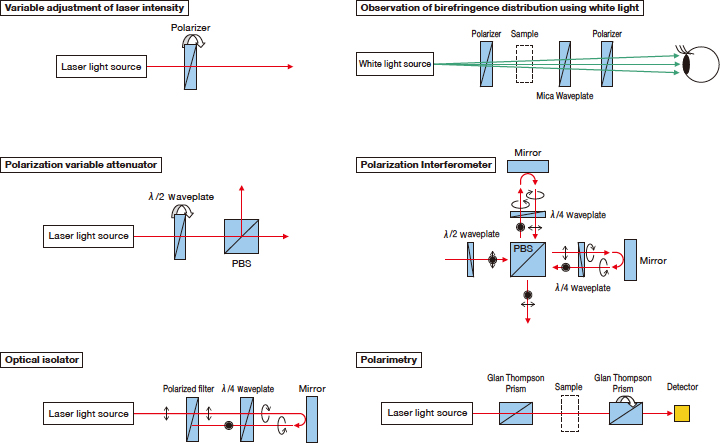Optics & optical coatings
Guide
Polarizers Selection Guide
Human eyes have no ability to perceive the polarization of light.
Also, the most of the optical detectors do not carry sensitivity of the polarization.
For this reason, filters that selectively transmit the light with specific polarization or optics that can change the polarization state become necessary.
In this page, a guidance is provided for finding a suitable application for the variety of polarization optics.
| Type of Polarizers | Type of Waveplates | Products | Features | Accuracy | Application |
|---|---|---|---|---|---|
| Plastic Sheet Polarizers (USP) |  |
Low cost, Lightweight |  |
Variable adjustment of laser intensity | |
| Mica Waveplates (WPM) |
 |
Substitute use as optical retarder Substitute use as phase sensitive color plate (visually intensify the retardance distribution) |
Observation of stress (birefringence) distribution | ||
| Polarizing Beamsplitters (PBS) |  |
Combine or separate the polarized beam | A simple polarization experimental setup, Polarizing optical systems (Variable attenuator, Polarization interferometer, Optical isolator) | ||
| Visible Sheet Polarizers (SPF) |
 |
Provide stationary linear polarization light in visible region | |||
| Quartz Waveplates (WPQ) |
 |
Provide exact optical retardation for each wavelength of laser | |||
| Glan Thompson Prisms (GTPC) |
 |
Provide linearly polarized light with excellent extinction ratio in visible region | Polarization measurements (Extinction ratio, Optical retardation) | ||
| Fresnel Rhombs Retarders (FRB) |
 |
Provide stationary optical retardation in a broad wavelength range. |




